
EXHIBIT 99.01

Investor Presentation September 2014 © 2014 Tonix Pharmaceuticals Holding Corp. NASDAQ: TNXP

Safe harbor s tatement Certain statements in this presentation regarding strategic plans, expectations and objectives for future operations or results are “forward - looking statements” as defined by the Private Securities Litigation Reform Act of 1995 . These statements may be identified by the use of forward - looking words such as "anticipate," "believe," "forecast," "estimate" and "intend," among others . These forward - looking statements are based on Tonix’s current expectations and actual results could differ materially . There are a number of factors that could cause actual events to differ materially from those indicated by such forward - looking statements . These factors include, but are not limited to, substantial competition ; our ability to continue as a going concern ; our need for additional financing ; uncertainties of patent protection and litigation ; uncertainties of government or third party payer reimbursement ; limited sales and marketing efforts and dependence upon third parties ; and risks related to failure to obtain U . S . Food and Drug Administration clearances or approvals and noncompliance with its regulations . As with any pharmaceutical under development, there are significant risks in the development, regulatory approval and commercialization of new products . The forward - looking statements in this presentation are made as of the date of this presentation, even if subsequently made available by the Company on its website or otherwise . Tonix does not undertake an obligation to update or revise any forward - looking statement, except as required by law . Investors should read the risk factors set forth in the amended Annual Report on Form 10 - K for the year ended December 31 , 2013 , as filed with the Securities and Exchange Commission (the “SEC”) on March 28 , 2014 and future periodic reports filed with the SEC on or after the date hereof . All of the Company's forward - looking statements are expressly qualified by all such risk factors and other cautionary statements 2

Tonix - Overview First - in - class medicines for common disorders of the central nervous system (CNS) New treatment paradigms Late stage candidates Large unmet medical needs All intellectual property owned by Tonix outright – no royalties Experienced team, strong balance sheet Track record of success in drug approvals and value creation Well - capitalized to execute on key near - term milestones Fibromyalgia – Report top line results from BESTFIT trial by October 15, 2014 3 Post - traumatic Stress Disorder – Phase 2 trial to begin in 4Q 2014 Episodic Tension - type Headache – To enter clinic in 1Q 2015

Development programs Preclinical Phase 1 Proof - of - Concept Pivotal NDA Market Candidate Indication *To conduct comparative pharmacokinetic and safety study in 1Q 2015 TNX - 102 SL (cyclobenzaprine HCl sublingual tablet) 2.8 mg is an Investigational New Drug and is not approved for any indication. TNX - 201 (isometheptene mucate single isomer) is not approved for any indication. Phase 2a Phase 2b/3 PTSD TNX - 102 SL Ph 2 to start 4Q14 2019E TNX - 102 SL Fibromyalgia To report top line results of BESTFIT trial by October 15, 2014 2017E 1Q15* TNX - 201 Headache 2019E 4

Targeting sleep quality in fibromyalgia (FM) and in post - traumatic stress disorder (PTSD) TNX - 102 SL is designed as a chronic therapy for bedtime use Non - restorative sleep linked to pain, fatigue, hyper - vigilance, and arousals Restorative sleep improves FM and PTSD symptoms Novel molecular target in tension headache Based on proprietary discoveries by Tonix Mechanism of action distinct from acetaminophen or barbiturates Goal – to introduce non - addictive therapeutics with the potential to decrease the use of: New approaches to treating CNS disorders Opiates Barbiturates Benzodiazepines Non - benzodiazepine sleep drugs 5

CONFIDENTIAL Fibromyalgia market opportunity * National Institutes of Health, U.S. Department of Health and Human Services ** Robinson et al, Pain 2012;13:1366 - 76 . *** Estimates based on information from publicly - available sources SNRI = Serotonin - Norepinephrine Reuptake Inhibitor 5 million U.S. patients* 2.6 million diagnosed; 2.4 million receiving treatment ** Three FDA approved prescription medications Category Product Company Approval Year in FM 2012 U.S. S ales in FM*** Membrane Stabilizer Lyrica ® Pfizer 2007 $475 million SNRI Cymbalta ® Eli Lilly 2008 $600 million Savella ® Forest 2009 $100 million Sleep Quality TNX - 102 SL Tonix 2017E 6

Fibromyalgia: many dissatisfied patients Chronic , widespread pain with sleep, fatigue, mood, and memory problems Typical patient has onset at 30 - 40 years of age with persistence for rest of life Impairs daily function and productivity; poor quality of life Predominantly female Patients remain unsatisfied despite approved products Patients often take multiple medications (“polypharmacy”) ‘ Off - label’ use of opioids and sedative - hypnotics despite no sustained benefit FM featured within FDA’s Patient - Focused Drug Development initiative Expensive, burdensome condition for the healthcare system Health utilization and medication costs are substantial Managed care / payers recognize need for new therapies 7

CONFIDENTIAL Fibromyalgia has a high economic impact Robinson et al, Pain Med. 2012;13(10):1366 - 76. Resource utilization over preceding 12 months Outpatient visits 82.9 % Any emergency room visit 40.2 % Mean number of emergency room visits † 2.4 Productivity measures over preceding 12 months Missed any work due to FM 47.4 % Mean days of work missed † 58.4 Received disability income benefits 29.9 % Mean months on disability † 10.6 † Means include only subjects who experienced the event. 8

CONFIDENTIAL >90% of fibromyalgia patients complain of poor sleep quality* Restorative sleep improves pain and other FM symptoms Sleep quality of fibromyalgia patients can be objectively measured: Cyclic Alternating P attern (CAP) A1 patterns indicate sleep stability A2, A3 patterns indicate sleep instability (poor sleep quality) Pain is the measure of fibromyalgia severity By improving sleep quality, chronic TNX - 102 SL therapy is designed to decrease pain * Source : Swick, Ther. Adv. Musculoskel. Dis. 2011;3(4):167 - 178. Sleep quality is a new target for FM therapy 9

CONFIDENTIAL Phase 2a trial of TNX - 102 capsules in FM Double - blind, randomized, placebo - controlled Conducted at two academic centers in Canada Enrolled 36 subjects with fibromyalgia; 18 per arm TNX - 102 capsules or placebo taken between dinner and bedtime daily Eight - week, dose - escalating study Daily dosing ranged from 1 – 4 mg of TNX - 102 Source: Moldofsky et al., J Rheum. 2011;38(12):2653 - 63 http ://jrheum.org/content/early/2011/08/30/jrheum.110194.full.pdf+html 10

CONFIDENTIAL -30 -25 -20 -15 -10 -5 0 % Change from Baseline at Week 8 Pain TNX - 102 Placebo Positive efficacy results from Phase 2a trial of TNX - 102 capsules in FM † Improving at least one night of CAP A2+A3(norm) ≤ 3 3% Mean TNX - 102 dose at trial end = 3.5 mg 26% reduction in pain vs. placebo Improvement in objective sleep quality measures vs. placebo * 0 10 20 30 40 50 60 70 80 % of Subjects† Sleep Quality TNX - 102 Placebo * * p < 0.05 11

CONFIDENTIAL Safety results from Phase 2a trial of TNX - 102 capsules in FM No serious adverse events No discontinuations due to adverse events in treatment arm Adverse Event TNX - 102, % (N=18) Placebo, % (N=18) Any adverse event 83 83 Headache 39 17 Dry mouth 33 6 Somnolence 22 11 Constipation 17 6 Dizziness 17 6 Nausea 11 28 Flu syndrome 11 6 Rhinitis 11 6 Pruritus 11 0 12

CONFIDENTIAL TNX - 102 SL is a sublingual tablet formulation optimized for chronic use at bedtime t ransmucosal absorption • efficacy • tolerability/safety • chronic use • bedtime therapy • compliance • metabolism Optimized for: TNX - 102 SL (sublingual) tablets Phase 2b/3 10x faster absorption* * Absorption lag time (t lag ) based on clinical pharmacokinetic data 13

CONFIDENTIAL R egistration program for TNX - 102 SL in FM Two adequate and well - controlled efficacy and safety trials in fibromyalgia patients Primary efficacy endpoint = pain □ First trial has completed – “BESTFIT”* □ Report top line results from BESTFIT by October 15, 2014 Long - term exposure data to support chronic use label 100 subjects for six months, 50 subjects for one year □ Open - label extension study is underway Definitive repeat dose pharmacokinetic “bridging” study x x * BESTFIT : BE dtime S ublingual T NX - 102 SL as F ibromyalgia I ntervention T herapy 14

CONFIDENTIAL “BESTFIT” potential pivotal trial - completed BESTFIT : BE dtime S ublingual T NX - 102 SL as F ibromyalgia I ntervention T herapy Randomized, double - blind, placebo - controlled; 17 U.S. sites Primary efficacy endpoint = change in pain at week 12 vs. baseline (Numeric Rating Scale) If successful, will serve as first of two pivotal studies to support TNX - 102 SL approval in FM R A N D O M I Z A T I O N Arm 1: TNX - 102 SL 2.8 mg, at bedtime nightly (n=100) Arm 2: Placebo, at bedtime nightly (n=100) 12 weeks open - label extension 15

CONFIDENTIAL * National Institutes of Health, U.S. Department of Health and Human Services ** Wang et al., Arch Gen Psych. 2005;62(6):167 - 78. SSRI = Selective Serotonin Reuptake Inhibitor 8.4 million U.S. patients* 4.2 million receiving medical treatment** Two FDA approved prescription medications Category Product Company Approval Year in PTSD SSRI Paxil ® Glaxo 2001 Zoloft ® Pfizer 1999 Sleep Quality TNX - 102 SL Tonix 2019E PTSD market opportunity P hase 2 efficacy study of TNX - 102 SL to begin in 4Q 2014 Leverage fibromyalgia formulation, clinical experience, manufacturing know - how 16

CONFIDENTIAL Post - traumatic s tress d isorder is a chronic debilitating condition Patients desperate despite two FDA approved drugs; no new treatment in >10 years Associated with suicide and unpredictable, violent behaviors 3.5 % of U.S. adult population has suffered from PTSD in past 12 months* Experiencing any trauma can lead to PTSD High incidence among U.S. soldiers and veterans Overlap between PTSD and FM ~50% of FM or PTSD patients meet criteria for the other disorder Patients experience disturbed sleep W idespread pain is considered “co - morbid” with PTSD Opioid and sedative - hypnotic drug misuse common * National Institutes of Mental Health & National Institutes of Health 2010 PTSD is an important public health problem 17
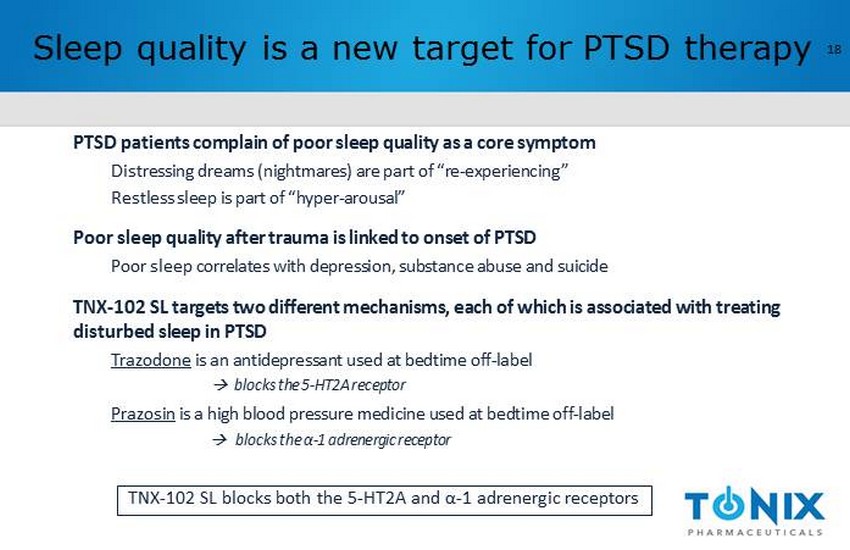
CONFIDENTIAL PTSD patients complain of poor sleep quality as a core symptom Distressing dreams (nightmares) are part of “re - experiencing” Restless sleep is part of “hyper - arousal” Poor sleep quality after trauma is linked to onset of PTSD Poor sleep correlates with depression, substance abuse and suicide TNX - 102 SL targets two different mechanisms, each of which is associated with treating disturbed sleep in PTSD Trazodone is an antidepressant used at bedtime off - label ; blocks the 5 - HT2A receptor Prazosin is a high blood pressure medicine used at bedtime off - label ; blocks the α - 1 adrenergic receptor Sleep quality is a new target for PTSD therapy TNX - 102 SL blocks both the 5 - HT2A and α - 1 adrenergic receptors 18
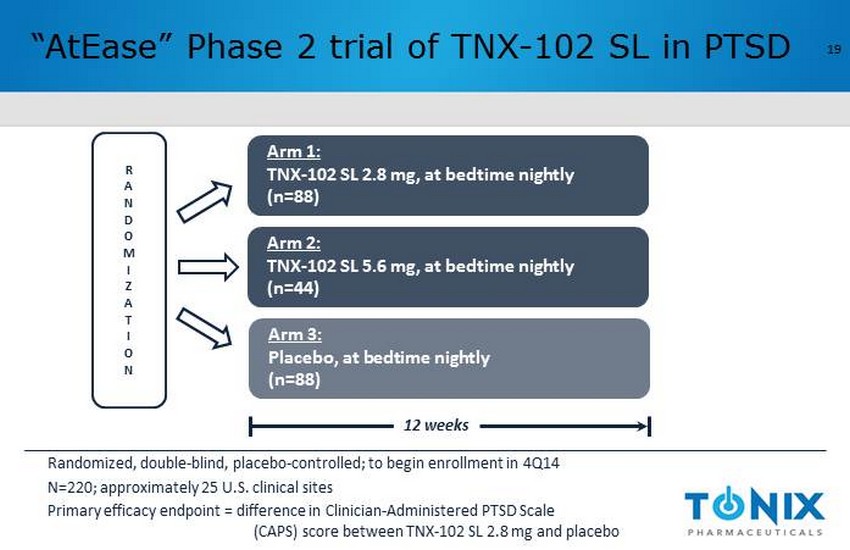
CONFIDENTIAL “AtEase” Phase 2 trial of TNX - 102 SL in PTSD Randomized , double - blind, placebo - controlled; to begin enrollment in 4Q14 N=220; approximately 25 U.S. clinical sites Primary efficacy endpoint = difference in Clinician - Administered PTSD Scale (CAPS) score between TNX - 102 SL 2.8 mg and placebo R A N D O M I Z A T I O N Arm 1: TNX - 102 SL 2.8 mg, at bedtime nightly (n=88) Arm 3: Placebo, at bedtime nightly (n=88) 12 weeks Arm 2: TNX - 102 SL 5.6 mg, at bedtime nightly (n=44) 19
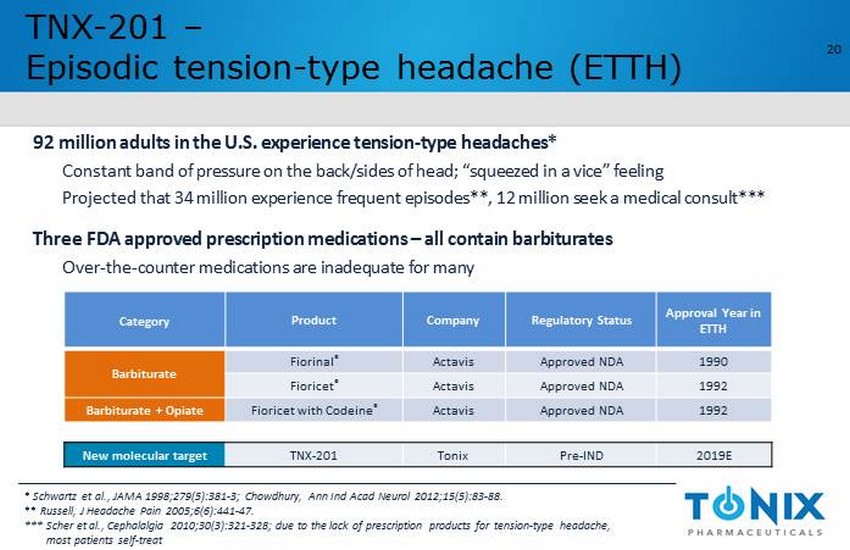
CONFIDENTIAL TNX - 201 – Episodic tension - type headache (ETTH) * Schwartz et al., JAMA 1998;279(5):381 - 3; Chowdhury, Ann Ind Acad Neurol 2012;15(5):83 - 88. ** Russell, J Headache Pain 2005;6(6):441 - 47. *** Scher et al., Cephalalgia 2010;30(3):321 - 328; due to the lack of prescription products for tension - type headache, most patients self - treat 92 million adults in the U.S. experience tension - type headaches* Constant band of pressure on the back/sides of head; “squeezed in a vice” feeling Projected that 34 million experience frequent episodes**, 12 million seek a medical consult *** Three FDA approved prescription medications – all contain barbiturates Over - the - counter medications are inadequate for many Category Product Company Regulatory Status Approval Year in ETTH Barbiturate Fiorinal ® Actavis Approved NDA 1990 Fioricet ® Actavis Approved NDA 1992 Barbiturate + Opiate Fioricet with Codeine ® Actavis Approved NDA 1992 New molecular target TNX - 201 Tonix Pre - IND 2019E 20

CONFIDENTIAL TNX - 201 to enter clinical development in 2015 Novel molecular mechanism Based on proprietary discoveries by Tonix Non - barbiturate, non - opioid Mechanism of action distinct from acetaminophen and barbiturates Comparative pharmacokinetic and safety study to be conducted in 1Q 2015 Pre - IND meeting with FDA held in January 2014 21

CONFIDENTIAL Intellectual property Composition - of - matter Patents filed Protection expected to 2034 Pharmacokinetics (PK) Patents filed Protection expected to 2033 Method - of - use FM: patents issued, 3Q 2020 expiry PTSD: patents filed TNX - 102 SL Fibromyalgia, PTSD TNX - 201 H eadache Composition - of - matter Patents filed Protection expected to 2033 All IP wholly - owned by Tonix – no royalties / future obligations 22
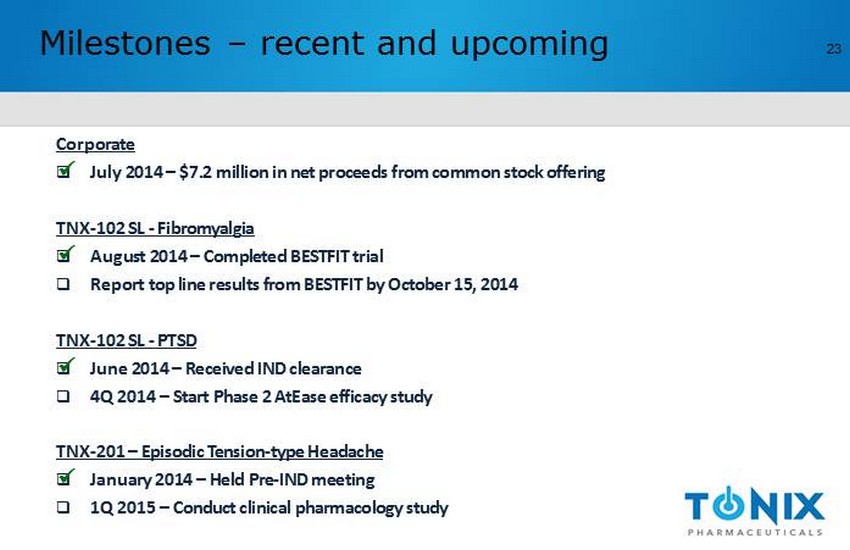
CONFIDENTIAL Milestones – recent and upcoming Corporate □ July 2014 – $7.2 million in net proceeds from common stock offering TNX - 102 SL - Fibromyalgia □ August 2014 – Completed BESTFIT trial □ Report top line results from BESTFIT by October 15, 2014 TNX - 102 SL - PTSD □ June 2014 – Received IND clearance □ 4Q 2014 – Start Phase 2 AtEase efficacy study TNX - 201 – Episodic Tension - type Headache □ January 2014 – Held Pre - IND meeting □ 1Q 2015 – Conduct clinical pharmacology study x x x x 23

CONFIDENTIAL Bruce Daugherty, PhD CSO Seth Lederman, MD CEO Management team Leland Gershell, MD, PhD CFO Don Kellerman, PharmD SVP, Clinical Development & Regulatory Affairs 24
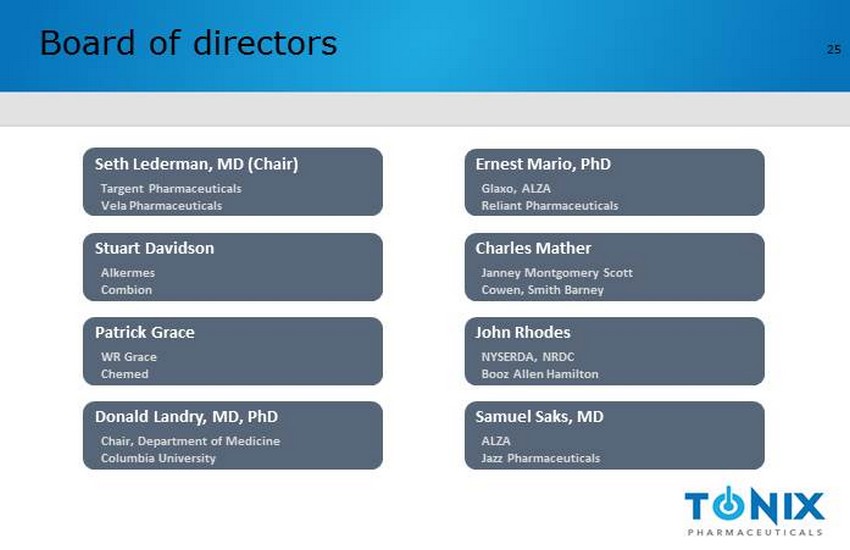
CONFIDENTIAL John Rhodes NYSERDA, NRDC Booz Allen Hamilton Donald Landry, MD, PhD Chair, Department of Medicine Columbia University Stuart Davidson Alkermes Combion Seth Lederman, MD (Chair) Targent Pharmaceuticals Vela Pharmaceuticals Samuel Saks, MD ALZA Jazz Pharmaceuticals Patrick Grace WR Grace Chemed Ernest Mario, PhD Glaxo, ALZA Reliant Pharmaceuticals Board of directors Charles Mather Janney Montgomery Scott Cowen, Smith Barney 25

CONFIDENTIAL Financial summary NASDAQ: TNXP Cash reported at June 30 , 2014* $ 43.9 million Net cash used in operations in 2Q14 $ 5.7 million Shares outstanding † 10.6 million * Does not include $7.2 million in net proceeds from stock offering in July 2014. † As of September 24, 2014 26
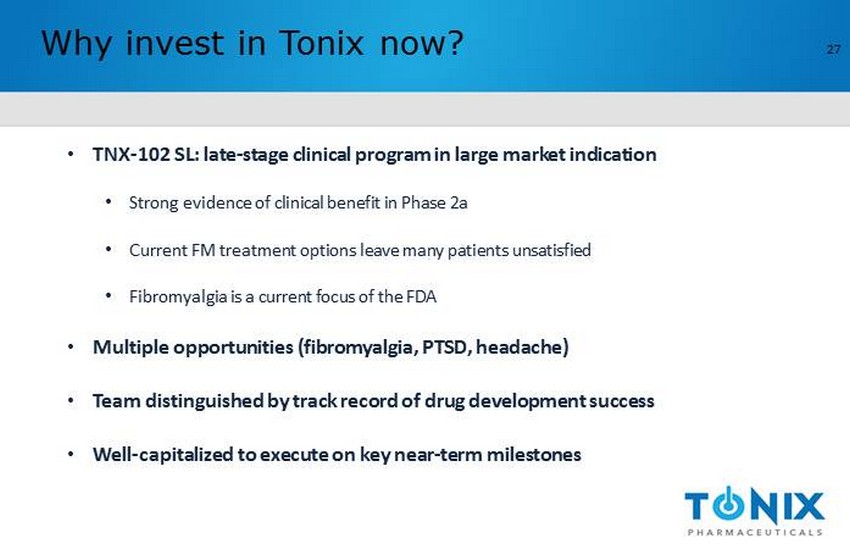
CONFIDENTIAL Why invest in Tonix now? • TNX - 102 SL: late - stage clinical program in large market indication • Strong evidence of clinical benefit in Phase 2a • Current FM treatment options leave many patients unsatisfied • Fibromyalgia is a current focus of the FDA • Multiple opportunities (fibromyalgia , PTSD, headache) • Team distinguished by track record of drug development success • Well - capitalized to execute on key near - term milestones 27
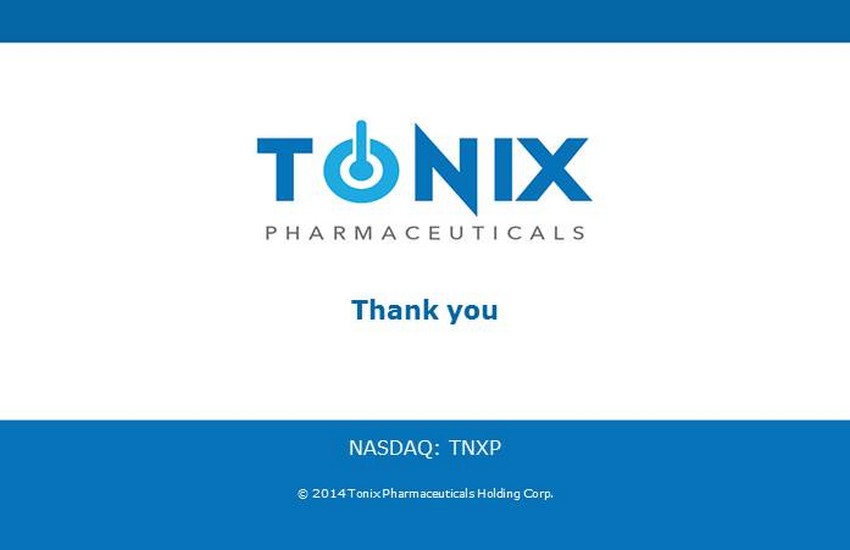
Thank you © 2014 Tonix Pharmaceuticals Holding Corp. NASDAQ: TNXP